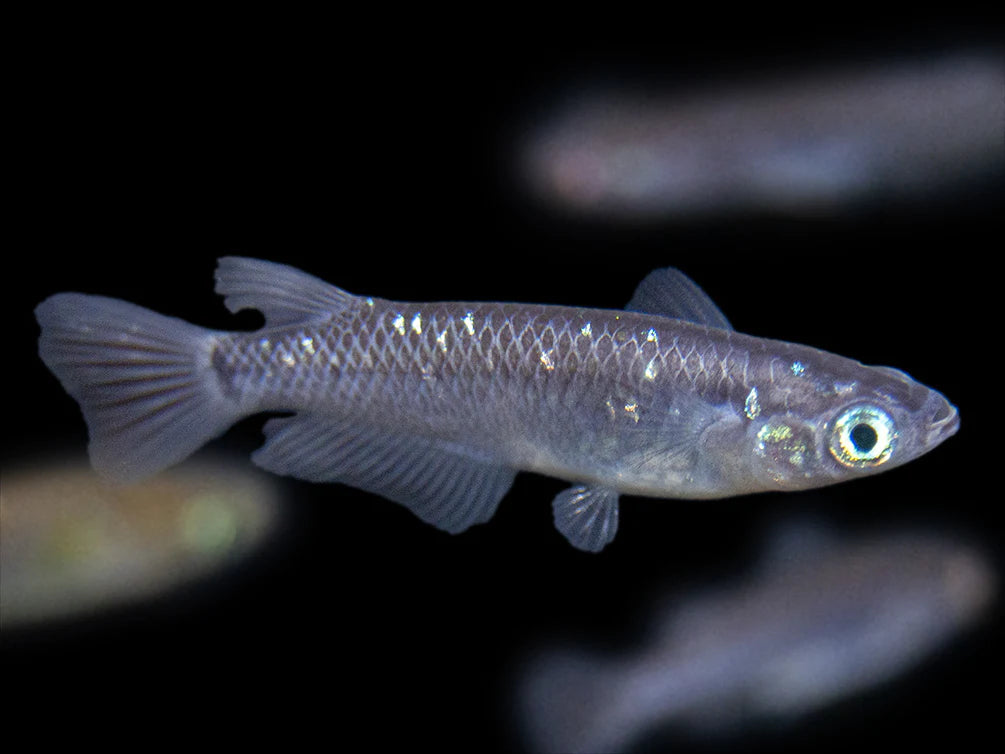| Common Name(s) | Japanese Rice Fish, Medaka, Ricefish, Japanese Killifish |
| Scientific Name | Oryzias latipes |
| Origin | Japan, Laos, Vietman, Eastern Korea, Eastern China |
| Temperature | 61-72°F (16-22°C) |
| Size | 1.5 inches (4 cm) |
| Minimum Tank Size | 10 gallons |
| Food & Diet | Omnivorous micropredator |
| Lifespan | 4 years |
| Water pH | 7.0-8.0 |
| Tank Mates | Peaceful fish of similar size |
| Breeding | Spawns adhesive eggs near vegetation. |
| Disease | While they are resilient fish, they may be susceptible to Ich. |

Japanese Rice Fish (Oryzias latipes)
The Japanese Rice Fish (Oryzias Latipes) has been an aquarium fish for aquarists because of its small size, hardiness, and colorful appearance. Japanese Rice Fish are also known as Medaka, Ricefish, and Japanese Killifish.
Japanese Rice Fish are native to Japan, as well as the neighboring countries of Southeast Asia and East Asia. This includes Laos, Vietnam, Taiwan, eastern Korea, and eastern China. They are found in rice paddies, ponds, streams, and other small bodies of water.
Japanese Rice Fish is a very special fish. In fact, they are a very special vertebrate. This fish has always been researched extensively as a model organism in toxicology labs. However, out of all of the model organisms that are studies in labs, Japanese Rice Fish carries the distinction of being the first vertebrate to mate in orbit. In 1994, in space flight mission STS-65 IML-2, Japanese Rice Fish (Oryzias Latipes) were able to successfully mate and fertilize in space. During the 15-day mission, four fish laid 43 eggs, and eight fry hatched in space. Another 30 fry hatched after landing. After returning to Earth, the fish that were hatched in space were able to produce offspring as well (Proshchina, 2021).
These fish are unique in that they are able to adapt to both freshwater and saltwater environments as well. Japanese Rice Fish are euryhaline species. While they usually inhabit freshwater, they are able to adapt to full-strength saltwater as well (Miyanishi, 2016). Of course, they must be transferred to a diluted saltwater environment before being introduced to full-strength saltwater, but this illustrates how adaptive and special these fish are.
While the wild-type Japanese Rice Fish is rather plain in appearance, there are varieties of this fish that are much more colorful. In addition to the various body color, there are different body shape, eye variation, and fin type. Regarding the body color, the fish has five primary colors which are black, red, yellow, blue, white, brown, and albino. From these primary colors, the fish are cross-bred to create different varieties. Based on these different colors and other categories, there are hundreds of different identified varieties of Japanese Rice Fish. In fact, these fish have been bred from centuries.
Here’s a list of some of the popular varieties of Japanese Rice Fish, also known as Medaka:
- Yokihi Medaka
- Miyuki Medaka
- Totenko Medaka
- Toumeirin Medaka
- Black Medaka
- White Medaka
- Blue Medaka
- Dharma Medaka
- Hatsukoi Medaka
- Pure Black Medaka
- Sansyoku Medaka
- Kohaku Medaka
- Ougon Medaka
- Pure Black Ougon Medaka
- Lame Medaka
- Swallow Medaka
- Sarasa Medaka
- Nishiki Medaka
- Ryusei Medaka
- Milky Way Medaka
- Marine Blue Medaka
- Black Miyuki Medaka
- Shinkai Medaka
- Three-Color Lame Miyuki Medaka
- Akakri Nishiki Medaka
- Phoenix Medaka
There are many more varieties of Japanese Rice Fish that are not listed here. In fact, the are currently over 500 varieties, and more are being identified each year.
Japanese Rice Fish Care
The Japanese Rice Fish are highly adaptable fish, so they are great for beginners. They are small fish that don’t require a large tank or an elaborate setup. In fact, in most climates, you can keep these fish without a heater. They can survive in outdoor ponds in most climates as well.
They are easy to feed, easy to maintain, and breed quite readily. Of course, a proper tank setup and regular maintenance is still required for these fish, but they are one of the easiest fish to care for.
Tank Setup
Japanese Rice fish do not require large aquariums, at least a 10 gallon tank is needed for a school of 6 fish. Naturally Rice Fish reside in rice paddies, shallow rivers and ponds so adding plants and sunlight to your aquarium is recommended. In Japan it is also common to keep Rice Fish in a ceramic bowl just outside the home.
Japanese Rice Fish need clean water, so regular water changes are necessary. In addition, an aquarium filter is recommended for most setups. If the tank is large enough and there are plenty of aquatic plants, only a sponge filter or air stone may be necessary.
In the wild Rice Fish move from freshwater to saltwater so either is acceptable for your aquarium setup. You may want to use freshwater in your setup as it is easier to maintain and freshwater will be better for the aquarium plants.
Keep in mind that ponds and shallow rivers are their natural habitats so keep your setup with calm water. You can use plants like Pistia and Water Hyacinth which will provide plenty of cover and a great breeding ground for your fish.
Rice Fish tend to leap out of their aquariums, putting a lid on your setup can be a good idea. A spongy lid with an air hole can help with the water and air quality.
Temperature & PH for Japanese Rice Fish
Japanese Rice Fish are very adaptable fish that can survive in a wide range of water parameters.
The optimal temperature range for Japanese Rice Fish is between 61-72°F (16-22°C). However, they are known to survive in a wider range of temperature between 3-42°C (37-108°F). Of course, keeping these fish in the lower and higher end of this range of temperature would be stressful for the fish. While they may survive in these extreme temperatures for a short period of time, their lifespan in such environments will be reduced. In addition, even within the same species, not all specimen will have the same tolerance levels. For successful fishkeeping, it is best to keep the fish in their optimal temperature range. Therefore, installing an aquarium heater and aquarium thermometer may be necessary in cold climates.
The ideal pH range for Japanese Rice Fish is between 7.0-8.0. It is best to test the water regularly to maintain optimal water parameters. In areas with water parameters that are unsuitable for the fish, reverse osmosis or de-ionization system can be used to get the ideal water quality.
Food & Diet
Japanese Rice Fish are omnivores by nature so flakes and freeze-dried food from a pet store is common. Occasionally, you can also feed them worms, mosquito larvae, small vegetables, and artemie saline. Feeding them at least twice a day is recommended.
Rice Fish are not aggressive and do not eat other fish, instead they eat the organisms that live in their mouth. Although live food has many of the nutrients they need, keep in mind that they are plant eaters first so feeding them live food should be sporadic.
Japanese Rice Fish Tank Mates
Naturally, Rice fish are small, peaceful fish so they can be tank mates with other peaceful fish but be aware it is not recommended to put larger fish (even if they are peaceful) as they can still show aggression towards the Rice Fish.
Keep in mind that Rice Fish are small, usually only 4 cm in length so they like to stay in schools to feel safe. They are very social fish and can even recognize the faces of other Rice Fish. When thinking of having tank mates for your Rice Fish choose peaceful fish that are the same size. It is rare for Rice Fish to show any aggression so adding a predator fish will be seen as a threat.
Japanese Rice Fish Lifespan
The lifespan of the Japanese Rice Fish is up to 4 years. For the longest life possible make sure that the habitat is under optimal conditions including a healthy diet.
Although Rice Fish are easy to take care of and require minimal care, regular maintenance and monitoring is needed for a long and happy life. As discussed earlier in this article optimal habit conditions and a healthy diet will produce the best quality life for your fish.
The natural habitats are ponds, rice paddies and shallow rivers so the closer your home setup replicates those conditions the happier your fish will be. Make sure to monitor the pH level and temperature of your water and make the necessary changes.
Within the acceptable range of temperatures, when they are kept in lower temperatures, they will live longer due to slower metabolism.
Breeding Japanese Rice Fish
Japanese Rice Fish will often lay eggs during spring and summer time. Rice Fish prefer to lay their eggs in grassy areas for cover so having an aquarium with plenty of bushy plants will be the optimum conditions for breeding.
If you are planning to breed your Rice Fish you’ll need to make sure that the water temperature is ideal (16-22 °C). The plants in your aquarium are crucial to the breeding process as they provide cover for the fertilized eggs. Java moss and spawning mops are good for breeding.
At first it may be difficult to identify the sex of the fish you have but male Rice Fish have have extended anal fins where as females do not. Once the eggs have been fertilized they will stay with the female until they get attached to the plants in your aquarium. It takes between 10 to 12 days for the eggs to hatch. Newly hatched fry will feed off infusoria and later baby brine. The new fry can grow quite quickly as it can take only a couple of weeks for them to grow.
If your fish are having trouble breeding you can feed them bloodworms or similar food to help them start breeding.
Japanese Rice Fish Diseases
In a well maintained aquarium disease is not an issue for the Japanese Rice Fish. However they are not immune to disease and can happen in ill maintained tanks or by the addition of fish and plants.
Although Rice Fish only need regular care, health problems and diseases can arise from dirty tanks or by the addition of fish or objects into the tank. To help prevent disease in your tank make sure you replace at least 30% of the water on a regular basis. Also if you are going to add plants, decorations or any other objects into your tank make sure you clean them before putting them in the water.
Having a good filtration system will also help prevent the spread of any bacteria in the water. A well-balanced healthy diet can also help your Rice Fish stave off any disease. A healthy well-maintained habitat keeps your fish happy and healthy ready to fight off disease. One positive thing about the Rice Fish is how strong and resilient they are. Often with other types of fish, when disease has entered the aquarium it can infect all the fish before any warning signs show up. For Rice Fish, disease does not easily spread and often can be caught before wide spreading can occur.
The first sign of disease is when the fish starts to show odd behavior. If you happen to notice this in your tank consult with your local pet store on treatment and clean your tank thoroughly.
Blog Source: https://www.fishlaboratory.com/fish/japanese-rice-fish/

